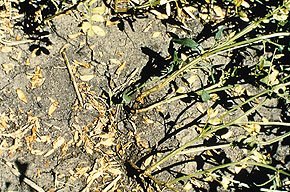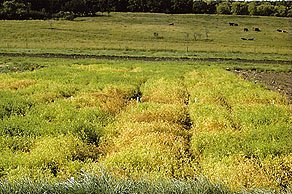Anthracnose on Lentils
This disease can cause yield losses in excess of 50%.


Host Crops
Lentils
Biology
Spores overwinter on seed and infected lentil stubble. The spores are released during the spring and early summer. Soilborne spores infect and kill the lower leaves and can cause premature plant death. Upper plant parts are usually infected later in the season from spores that are spread by splashing rain. Wind plays little role in the spread of this disease other than the fact that the fungus can be spread by dust during harvest.
Spore production is favoured by soils with high pH and cool to warm wet weather during June and July. Nutritionally stressed crops are especially susceptible.
Symptoms Of Damage
Brown lens-shaped lesions appear on the leaves. They are less distinct than those of ascochyta blight. Small, bristle-like, sporebearing structures appear on affected stems. The crown and lower stem areas become bleached and then turn brown. The disease can cause plant defoliation and premature death. Small black fruiting bodies are produced on dead tissue. Crown infections reduce plant vigour and cause premature ripening.
Scouting Techniques
Typical field symptoms are lodged plants with abnormally dark-brown stems. The lesions appear on the pods, stems, leaves, and seed. They are grey to black in colour and appear sunken. A salmon-coloured ooze may appear in the centre of the lesion. The lesions may start out as small black spots. In mid-season, the leaves may start to fall off rapidly. The leaf veins will appear darkened. The stem will darken in colour and appear weakened.
Economic Thresholds
None available.
Control Tips
Follow a crop rotation of at least three years between lentils and field peas. Plant disease-free, treated seed. Choose a less susceptible or resistant cultivar and use a recommended foliar fungicide if required.

